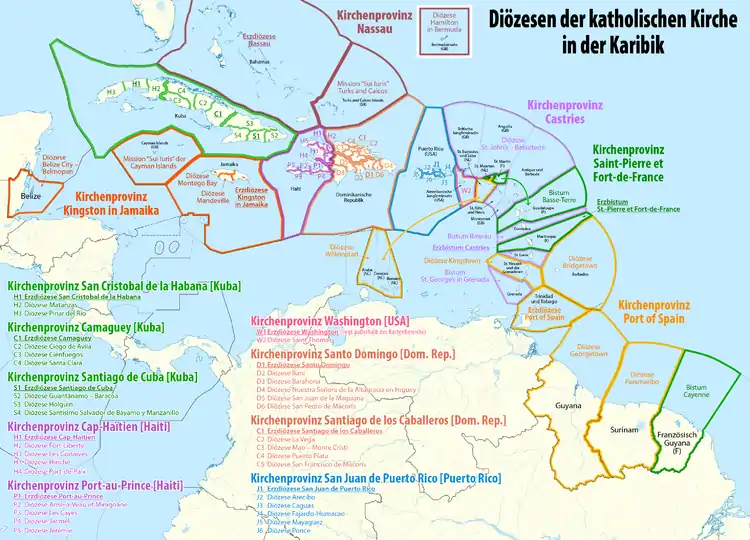Bistum Ciego de Ávila
Das Bistum Ciego de Ávila (lat.: Dioecesis Caeci Abulensis) ist eine auf Kuba gelegene römisch-katholische Diözese mit Sitz in Ciego de Ávila.
| Bistum Ciego de Ávila | |
 Karte Bistum Ciego de Ávila | |
| Basisdaten | |
|---|---|
| Staat | Kuba |
| Metropolitanbistum | Erzbistum Camagüey |
| Diözesanbischof | Juan Gabriel Diaz Ruiz |
| Emeritierter Diözesanbischof | Mario Eusebio Mestril Vega |
| Gründung | 1996 |
| Fläche | 7887 km² |
| Pfarreien | 7 (2019 / AP 2020) |
| Einwohner | 467.000 (2019 / AP 2020) |
| Katholiken | 191.830 (2019 / AP 2020) |
| Anteil | 41,1 % |
| Diözesanpriester | 7 (2019 / AP 2020) |
| Ordenspriester | 7 (2019 / AP 2020) |
| Katholiken je Priester | 13.702 |
| Ständige Diakone | 2 (2019 / AP 2020) |
| Ordensbrüder | 7 (2019 / AP 2020) |
| Ordensschwestern | 18 (2019 / AP 2020) |
| Ritus | Römischer Ritus |
| Liturgiesprache | Spanisch |
| Kathedrale | Catedral de San Eugenio de la Palma |
Geschichte
 Kathedrale San Eugenio |
Das Bistum Ciego de Ávila wurde am 2. Februar 1996 durch Papst Johannes Paul II. mit der Apostolischen Konstitution Universale Ecclesiae aus Gebietsabtretungen des Bistums Camagüey errichtet.[1] Es wurde dem Erzbistum Camagüey als Suffraganbistum unterstellt. Erster Bischof wurde Mario Eusebio Mestril Vega.
Bischöfe von Ciego de Ávila
- Mario Eusebio Mestril Vega, 1996–2017
- Juan Gabriel Diaz Ruiz, seit 2017
Weblinks
Einzelnachweise
- Ioannes Paulus II: Const. Apost. Universale Ecclesiae, AAS 88 (1996), n. 7, S. 609f.
This article is issued from Wikipedia. The text is licensed under Creative Commons - Attribution - Sharealike. The authors of the article are listed here. Additional terms may apply for the media files, click on images to show image meta data.